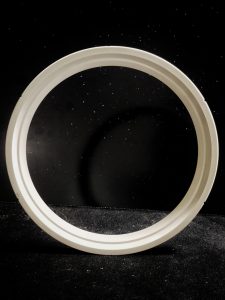PTFE Products
Brochure
Download our document to see specific data of the service and how we work.
DOWNLOAD BROCHURE

Valve Seat
Ball valves are essential in allowing to cut or pass the flow and pressure of a piping system. Moreover, they are used in industries such as the petrochemical and pharmaceutical where leakage could represent a terrible consequence for the environment or the product itself. Therefore, the ball valve seat is critical in such situations since it is responsible for sealing the fluid inside and distributing the seating stress uniformly.
Types
| VALVE SEAT MATERIAL SELECTION | |||
| We have a broad range of valve seat materials to suit your application, have a look at the table below | |||
| Material Name | Properties | Note | Temperature Range |
| VIRGIN PTFE | Very low coefficient of friction and excellent chemical resistance. | FDA approved | -40°C to 260°C |
| 15% GLASS FILLED PTFE | Decreased compressive strength and lower deformation under load than virgin PTFE. | Abrasive material | -40°C to 260°C |
| 25% GLASS FILLED PTFE | Similar to 15% Glass better wear resistance, higher compressive strength and lower deformation under load. | Abrasive material | -40°C to 260°C |
| TFM | Much denser polymer structure than Virgin PTFE. Displays better stress recovery. | Modified TFE Polymer | -40°C to 260°C |
| UHMW | Highly resistant to corrosive chemicals, with the exception of oxidising acids and organic solvents. | Also known as High Modulus Polyethylene High Performance Polyethylene | -40°C to +80°C |
| PCTFE | Excellent for cryogenic and Oxygen use. | A homo-polymer of Chlorotrifluoroethylene | -270°C to 260°C |
| PEEK | Retains all key features and benefits of PEEK 450G but retains physical properties to a higher temperature. | Can be supplied in both virgin unfilled or as filled compounded material | up to 260°C |
| DELRIN | Displays good resistance to wear and deformation under load. | Excellent for valve seat applications | up to 80°C |
